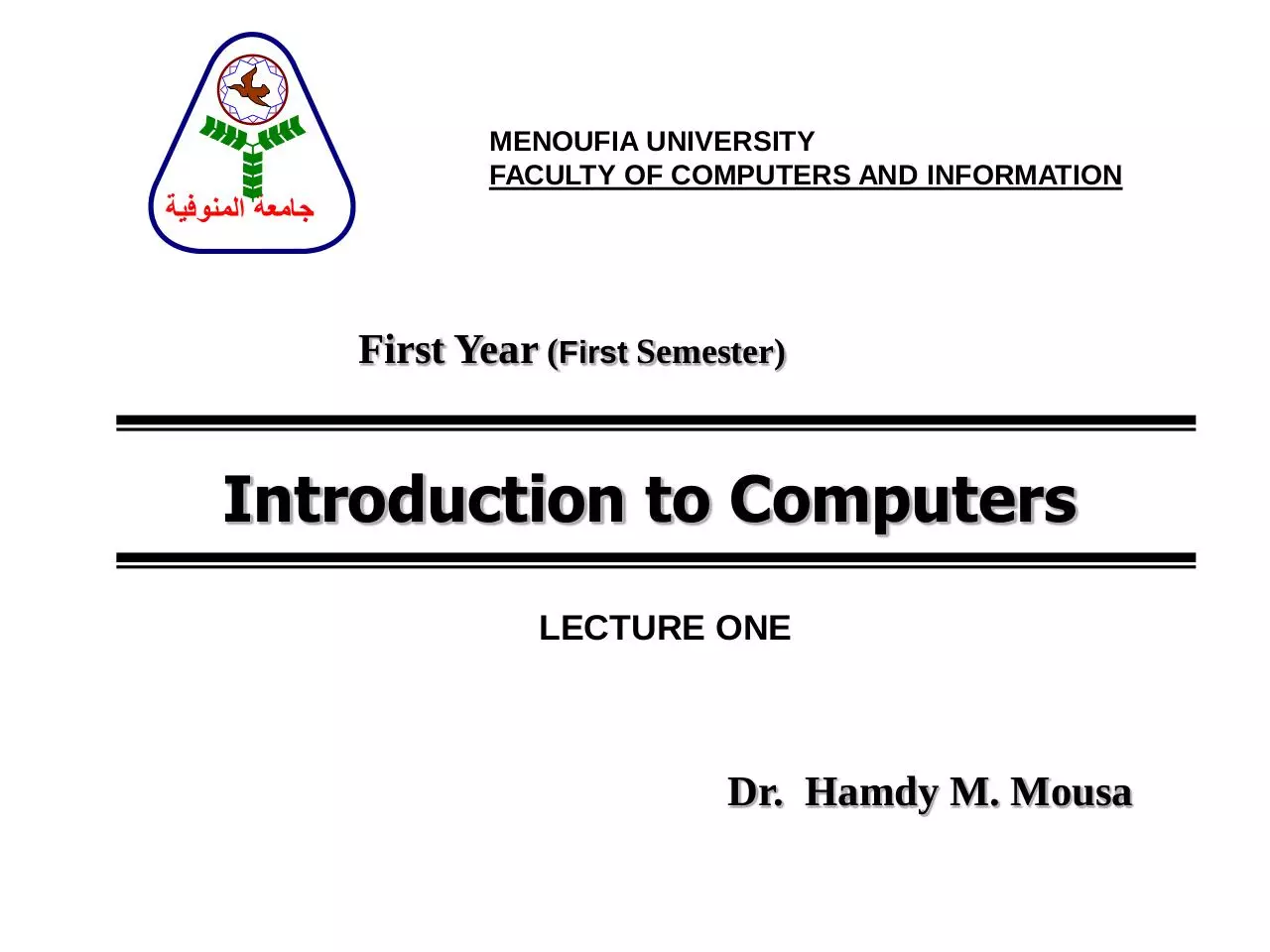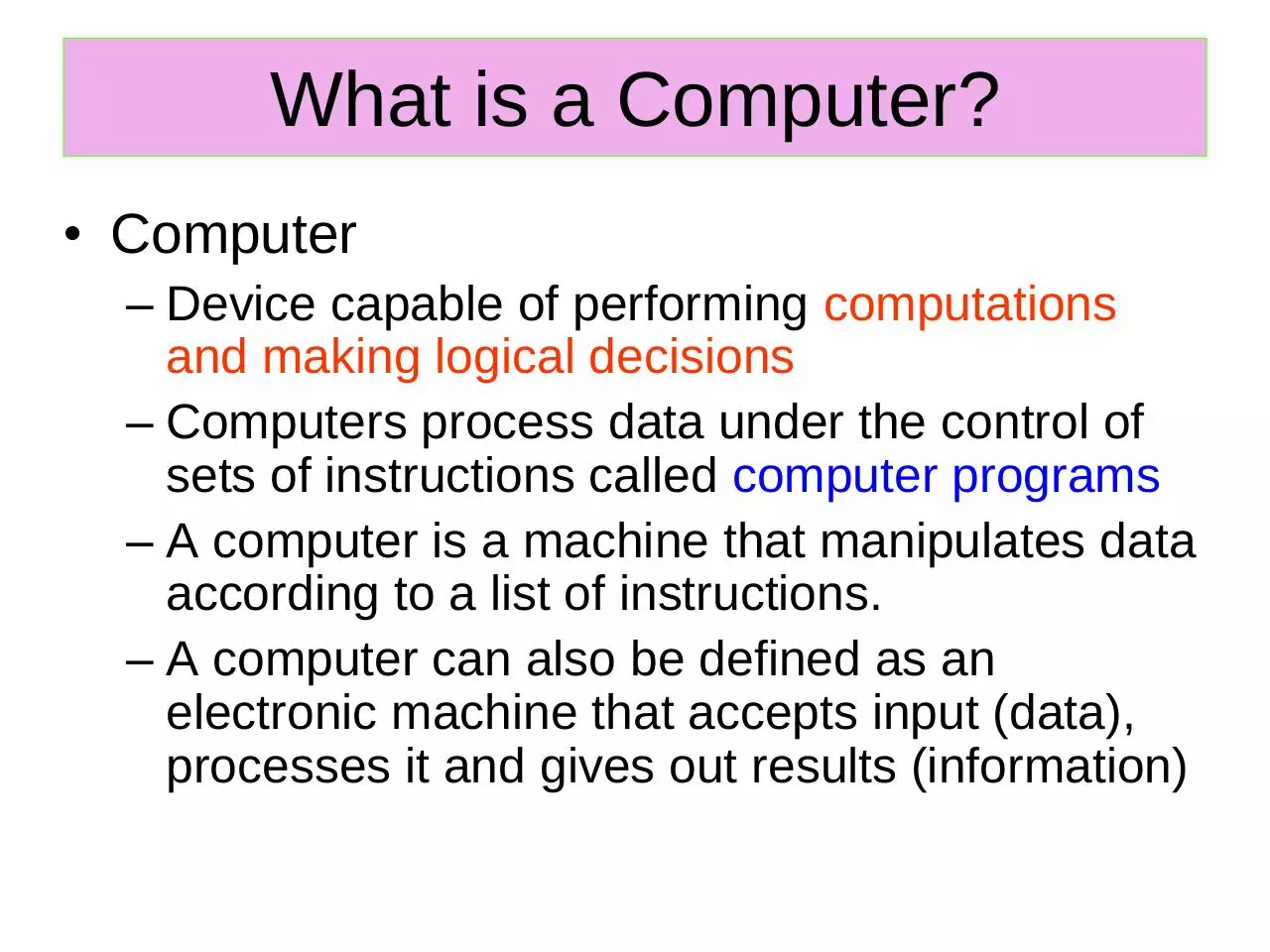lecture1 Intro (PDF)
File information
Title: Computers and Flowcharts
Author: Dr. Eng. H. M. Mousa
This PDF 1.5 document has been generated by Microsoft® PowerPoint® 2010, and has been sent on pdf-archive.com on 06/11/2015 at 09:06, from IP address 41.232.x.x.
The current document download page has been viewed 628 times.
File size: 1.32 MB (46 pages).
Privacy: public file





File preview
MENOUFIA UNIVERSITY
FACULTY OF COMPUTERS AND INFORMATION
جامعة المنوفية
First Year (First Semester)
Introduction to Computers
LECTURE ONE
Dr. Hamdy M. Mousa
Introduction to Computers
What is a Computer?
• Computer
– Device capable of performing computations
and making logical decisions
– Computers process data under the control of
sets of instructions called computer programs
– A computer is a machine that manipulates data
according to a list of instructions.
– A computer can also be defined as an
electronic machine that accepts input (data),
processes it and gives out results (information)
What is a Computer?
• Hardware
– Various devices comprising a computer
• Keyboard, screen, mouse, disks, memory, CD-ROM, and
processing units
• Software
– Programs that run on a computer
• Data and Information
– Computers process data into information.
– Data (data is plural for datum) is a collection of
unprocessed items, which can include text,
numbers, images, audio, and video.
– Information conveys meaning and is useful to
people.
COMPUTER
A computer is a programmable machine. The two
principal characteristics of a computer are:
– It responds to a specific set of instructions in a welldefined manner.
– It can execute a prerecorded list of instructions (a
program).
• Modem computers are electronic and digital.
– The actual machinery –wires, translators, and circuits
- is called hardware;
– the instructions and data are called software.
COMPUTER
CRT Display
“The Box”
CD-ROM Drive
Floppy
Disk
Drive
Keyboard
Mouse
Computers, Memory, and Input/Output
• A basic computer consists of three major
components: CPU (Central Processing Unit), I/O
(Input/Output), and Memory
• Data comes through Input and the CPU processes the data based
on a program which is in Memory. The result is returned to
Memory or is presented to the user.
• CPU itself consists of Arithmetic and Logic Unit (ALU), Control Unit
(CU) and Registers.
•
•
In addition to these components, many others
make it possible for the basic components of a
computer to work together efficiently.
For example, every computer requires a bus that
transmits data from one part of the computer to
another.
Computers, Memory, and Input/Output
Five Classic Components
• Since the 1940’s, computers have 5 classic components
Computer
• Input devices
Devices
Processor
– Keyboard, mouse, …
Input
Control
• Output devices
Memory
Datapath
Output
– Display, printer, …
• Storage devices
– Volatile memory devices: DRAM, SRAM, …
– Permanent storage devices: Magnetic, Optical, and Flash
disks, …
• Datapath
Together, they are called the Processor
• Control
• Newly 6th component: Network
– Essential component for communication in any computer
system
Download lecture1 Intro
lecture1_Intro.pdf (PDF, 1.32 MB)
Download PDF
Share this file on social networks
Link to this page
Permanent link
Use the permanent link to the download page to share your document on Facebook, Twitter, LinkedIn, or directly with a contact by e-Mail, Messenger, Whatsapp, Line..
Short link
Use the short link to share your document on Twitter or by text message (SMS)
HTML Code
Copy the following HTML code to share your document on a Website or Blog
QR Code to this page

This file has been shared publicly by a user of PDF Archive.
Document ID: 0000313127.